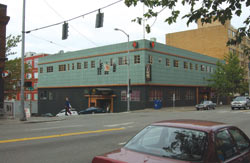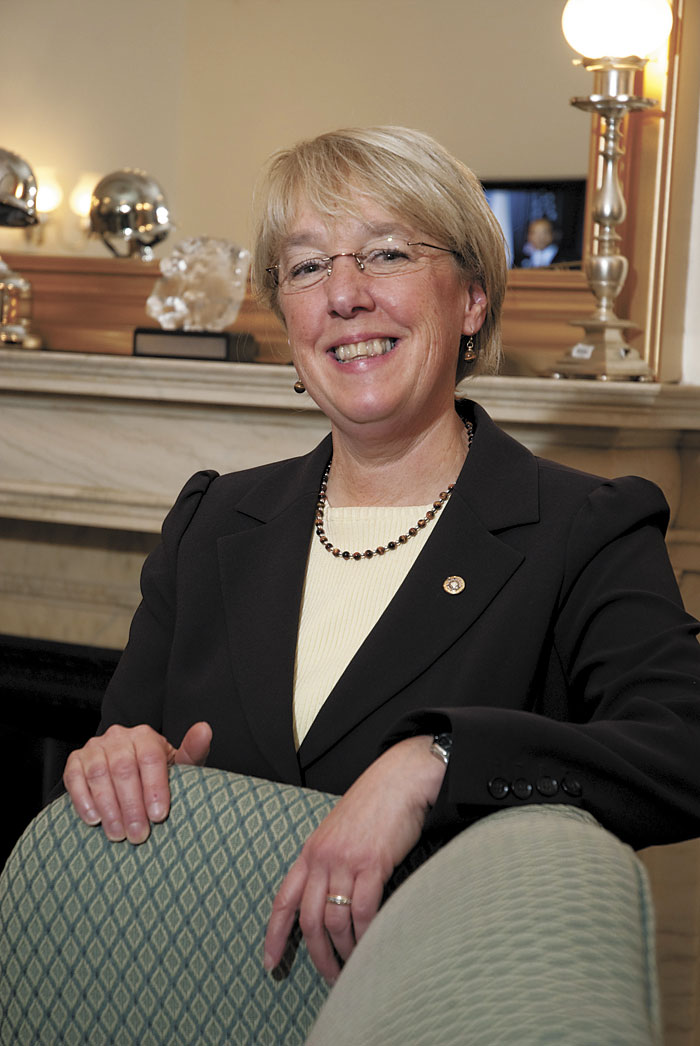City Council member Peter Steinbrueck makes no apologies for his crusade to designate dozens of downtown Seattle buildings as historic landmarks. In fact, if he could, he’d extend the effort “all over the place, not just downtown,” he says. “We’re working against time and development pressures that have the upper hand.”
Steinbrueck says simply that he’s “passionate about preservation,” and it’s safe to say it’s in his blood. His late father, and local hero, Victor Steinbrueck, is credited with saving Pike Place Market in the 1970s by spearheading a massive preservation effort that thwarted development interests. The elder Steinbrueck, an architecture professor who never held public office, also helped establish the Pioneer Square historic district.
But there are some who wonder whether there’s another motive at work—particularly since Peter Steinbrueck, after 10 years on the City Council, is stepping down shortly and admits to having his eye on a higher office.
Bruce Cowen, who owns the Ace Hotel building and the El Gaucho building (both in Belltown and included in the city’s recent inventory of potential landmarks), says the latest initiative smacks of grandstanding. “The general feeling seems to be it’s politically motivated and somebody wants to be mayor,” he says, referring to Steinbrueck. “It’s without total regard for the factors that make a building historic.”
Even Art Skolnik, the state’s first historic preservation officer, is opposed to the plan, saying the city is overreaching and that the effort could backfire. “I want to see as much history preserved as possible,” says Skolnik, who helped craft the ordinance that created Seattle’s Landmark Preservation Board. But, he says, “You have to maintain the trust with the property owners or you throw out years of progress.” He adds: “Shame on Peter Steinbrueck, getting his name out there at a time when he’s running for mayor.”
For the record, Steinbrueck says he’s not planning a mayoral bid, at least not yet. “This has nothing to do with that,” he says. “My motives are pure.”
But Steinbrueck’s not shy about saying that the mass-landmarking effort, which he helped set into motion last year by sponsoring so-called “livability” legislation, is part of the legacy he hopes to leave. “I came to council to do good things and to put the greater good before special interests and property owners. This is all part of that. I want to do everything I can before I go.”
Last month, the city released a list of 37 downtown properties eligible for nomination as Seattle landmarks. They include everything from low-slung slabs to tall towers and five of the city’s waterfront piers. An additional 56 buildings were identified to be considered for nomination next year.
Landmark nominations can be made by any person or group. This list of eligible properties was created by a consultant, whose work was funded in the city’s budget in connection with the livability legislation approved by the City Council last year. The measure was designed to offset the effects of the mayor’s plan that changed zoning to allow for taller buildings and greater density downtown.
The landmark effort only encompasses buildings located between Elliott Bay and I-5, Denny Way and Pioneer Square. Skolnik says nomination of 37 buildings would represent a “nuclear pace” compared to the average of two buildings annually that the city typically nominates for landmark designation downtown.
Karen Gordon, Seattle’s historic preservation officer, couldn’t confirm these numbers, but she says, “We always have a steady stream of nominations, whether we prepare them or not.” She adds that the city undertook a similar effort to nominate dozens of properties for designation 23 years ago. “It’s usually based on resources that we have available,” Gordon says. “We haven’t had funding to prepare nominations for a long time.” She stressed that the inventory is the first step in a long process. The city’s Landmark Preservation Board, a group of appointed citizens, will choose nominees from the list and then decide which to approve.
Skolnik says it doesn’t matter that the designations, or even the nominations, aren’t official. Once the property shows up on a list, he says, the building is “marked,” and the owner won’t be able to sell or alter it. “The city thinks it’s honorific, but it’s like having the plague,” Skolnik says. “Everyone stays away from you.”
And the effects are felt over the entire block, he says. “When you throw the net out to 37 properties, you freeze a lot of real estate downtown,” he says. “It’s an abusive action that threatens the cooperation between property owners and government to the point where it could undo that relationship.”
Tina Lee, who owns the building at Fourth and Bell that houses the Two Bells Tavern—which is on the list of potential historic nominees—says she feels like she’s “getting cornered into something. We own the property and now we have to deal with the Seattle process, which is a nightmare.”
If Two Bells is designated a historic landmark, for example, Lee could be prohibited from painting her storefront or adding signs. If the city finds value in the interior, Lee could also be prevented from changing things like the molding or the bar. (The City Council can also grant property owners relief by allowing rezoning to accommodate different uses, or bending building-code rules to make the building more marketable.)
“My father immigrated to Seattle from Italy in 1917. The sense of the past is important to a number of us, not just the preservation board,” Lee says. “The irony is, we preserved the building’s facade and tried to bring it back the way it was, and we kind of get ambushed for doing that.
“It’s not the Pike Place Market. It really isn’t,” she says of the Two Bells building. Without the facade, she says, it’s a “cinder-block building on a cement slab with a tar roof.”
According to city documents, the Two Bells is one of several Belltown buildings designed by George Wellington Stoddard of Stoddard & Son (best known for designing Memorial Stadium at Seattle Center) and a “fine example of innovative 1920s ornamentation.”
Paul Lambros, executive director of the Plymouth Housing Group, says his organization received no notice before its building on Second and Bell, the William Tell Apartments, showed up on the city’s list. He says the William Tell, which at one time provided housing for the homeless, is mostly vacant today and Plymouth, a nonprofit that serves very low-income tenants, had been considering selling the parcel to raise funds to develop more housing. “We’re all for landmarking,” he says, but adds that it will probably reduce the property value.
“No, we didn’t consult with [property owners] every step of the way,” says the city’s Gordon. “It was a survey and planning effort done by consultants. But no decision has been made yet.”
Steinbrueck adds that designating landmarks has been a very public part of the city’s livability plan. “If property owners are acting surprised,” he says, “they just weren’t paying attention.”
Though he says he’s not planning a mayoral bid today, Steinbrueck doesn’t deny his ambition for higher office. He says the mayor’s post “is a job I may decide to seek one day. A congressional office is also something that I would consider one day. But not now.”
He sees the landmark debate as “particularly important at a time of immense growth and change in our city. Basically, there’s a battle between property rights and what I would call deeper values in our city.” Historic preservation is critical to the long-term health of Seattle’s downtown, Steinbrueck maintains. “There are economic benefits to preserving history, authenticity, and character. It’s what sets our city apart from other places that are anonymous, ugly, and nondescript.” He says the Market is a perfect example. “It has brought immeasurable economic value to downtown and to the city and continues to do so,” he says. “The economic benefits of preservation should not just be measured site-by-site or owner-by-owner.”
Meanwhile, Skolnik’s helping to organize building owners for what could be either a lawsuit against the city or a ballot initiative that makes landmark designation a voluntary process requiring property-owner permission. He says there’s a lot of interest so far. “In terms of general public appeal, you have to think of this in terms of the whole city. The fact is, they can designate your house,” he says.
If Steinbrueck could, he just might. Or at least the homes of the likes of Skolnik, he says. Skolnik, separately, also indicated he’d like to landmark Steinbrueck’s residence. “These people make me crazy,” Skolnik says. “The only way to get through to them is to designate their house.”






